Is the Erotic Museum in Amsterdam erotic? A review
The short answer to the question in the title is “No, the Erotic Museum Amsterdam is not erotic.” What is it? Thought provoking and sometimes disturbing.
Why I didn’t go to the Erotic Museum Amsterdam before
You may remember that I reviewed the Sex Museum some time ago, calling it “the cure for insomnia.” I was with a couple of friends, and, after being decidedly underwhelmed by the Sex Museum, we walked to the Red Light District to see the Erotic Museum.
Disclosure: This article contains affiliate links. If you make a purchase or booking after clicking on one, I will receive a small commission. This will not affect your price.
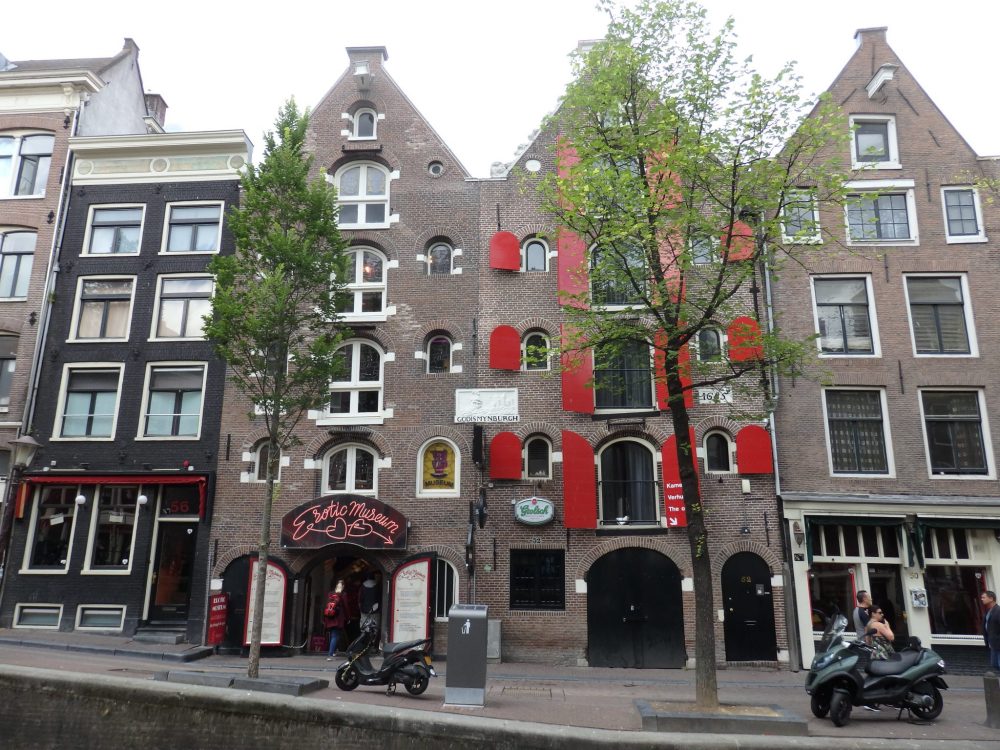
Looking inside the entrance, what we saw made us change our mind. A mannequin of a Dutch woman (made clear because of the traditional hat and clogs she wore) sat on a bicycle, smiling broadly, while the wheels turned. The bike’s blingy Swarovski crystal decoration wasn’t what inspired the smile on the mannequin. Without being too explicit, let’s just say that something under the saddle moved every time the wheels turned on the bike.
That day, after seeing far too much pornography already, we decided against visiting the Erotic Museum. Nevertheless, I have every intention of visiting every small museum in Amsterdam for this series, so I kept it on the list for future visits.
Recently a friend was in town for a conference, and we decided to go to the Erotic Museum, which bills itself this way: “With a collection of erotic art from all over the world, the five-story museum breathes the spirit of eroticism that makes the ‘red light district’ so special.”
Planning a visit to Amsterdam? Use the map below to find accommodations:
Tackiness at the Erotic Museum Amsterdam
If the intention of this museum is to show art, why start with that incredibly tacky mannequin + bike + crystal + dildo? I don’t think anyone would call that art. It’s a crass marketing ploy to lure people in: a promise of further titillation.
Fortunately, most of the rest of the museum isn’t as tacky. But the implication of the sign on the door – that the museum spotlights erotic art – led us to wander the rooms debating one question: where is the dividing line between art and pornography?
The first room, up one flight from the bicycle mannequin, holds items involving pornographic pictures. We saw small boxes with images of sexual acts inside. A range of ceramics, glass, metal and wooden objects depict sexual acts, but many just show nudes. Some are antiques, coming from a range of countries and time periods.
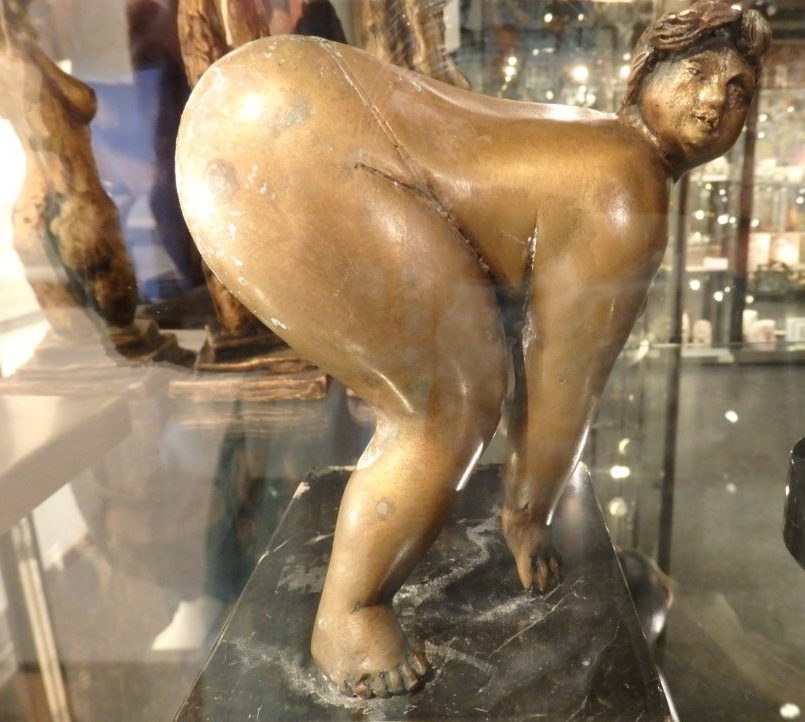
Many of the objects show careful detail and craftsmanship and some are centuries old. Nevertheless, just because something is old or skillfully made doesn’t mean that it’s not pornographic. In other words, if the ancient Pompeiian terra-cotta oil lamp that depicts a sexual act was intended as pornography, isn’t it still?
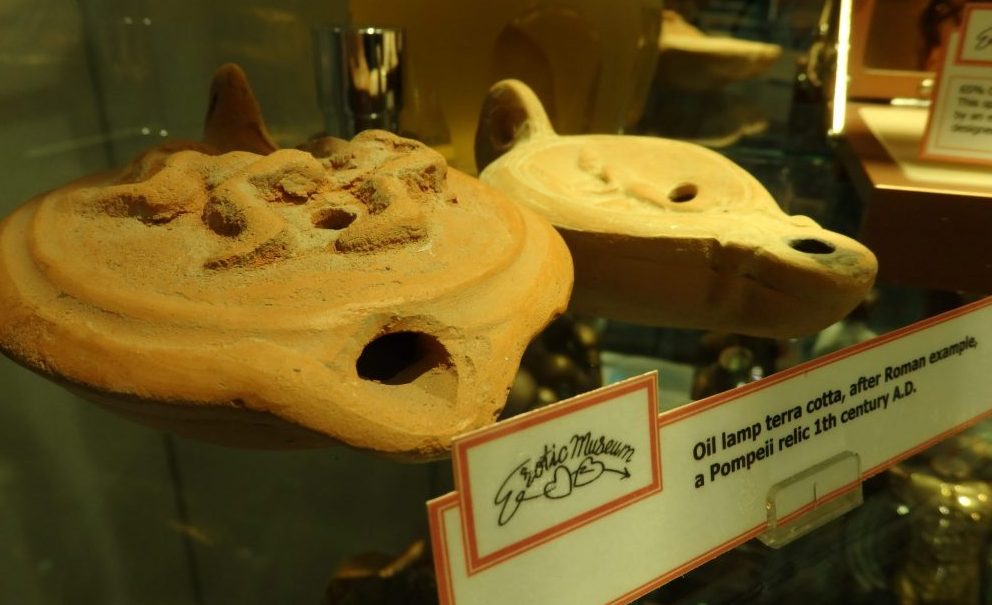
Clearly the context is important. If an African statue of a fertility god with an enormous erect penis was originally intended to help women conceive, then, in my view, it isn’t pornographic. Whether something is pornographic or not depends on the person viewing it, and that person’s cultural context. Yet most of the objects have no contextual explanation.
It surprised me to see a collection of John Lennon’s drawings on one wall, only a couple of which are sexually explicit. Most are simple representations of him and his wife, Yoko Ono. To me, these are art, even the explicit ones. Is that because of my context, the fact that I respect John Lennon?
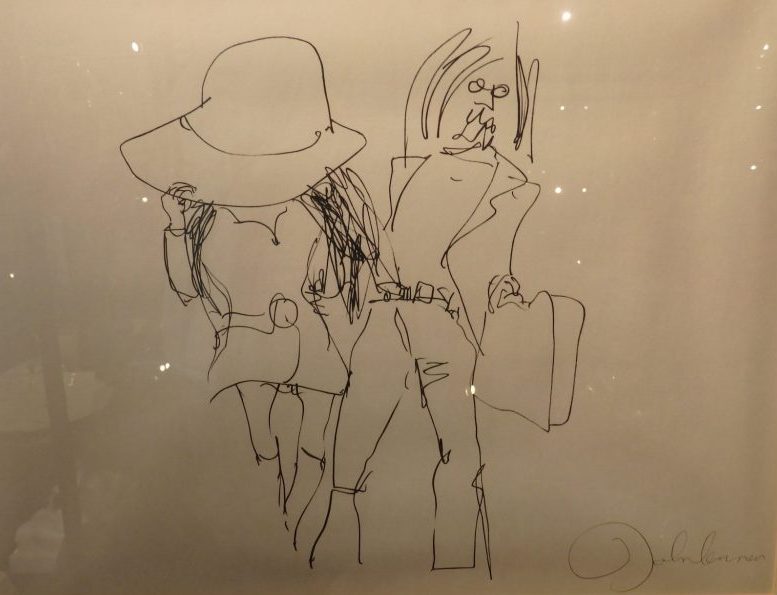
The “children’s” section?
On the second floor, one room looks like it’s for kids: at first glance, anyway. I remarked to my friend my surprise at seeing a kids’ section: can kids even enter this museum?
On second glance, however, it became clear that this is definitely not a kids’ section. It has low, brightly painted stools for watching one of the two screens in the room. Yet the life-sized cartoons painted on the wall depict, among other things, a mostly naked Disney Snow White, with the seven dwarves fully clothed and staring at her. Prince Charming ogles her, practically drooling and visibly excited, if you get my drift, at the sight of her.
Set into the wall, the two TVs show animated pornography, with typical children’s cartoon figures in the lead roles. I admit that I didn’t even know that was a thing. And I didn’t stay around long enough to see what film they were showing.
Other articles you might also want to read:
Art and sadomasochism at the Erotic Museum Amsterdam
The best part of the museum is on the third floor, which looks more like a traditional art gallery. A range of artists’ work is on display for sale, and it is, in my biased view, good art. While some of it is explicit, it goes beyond just illustrating sexual acts.
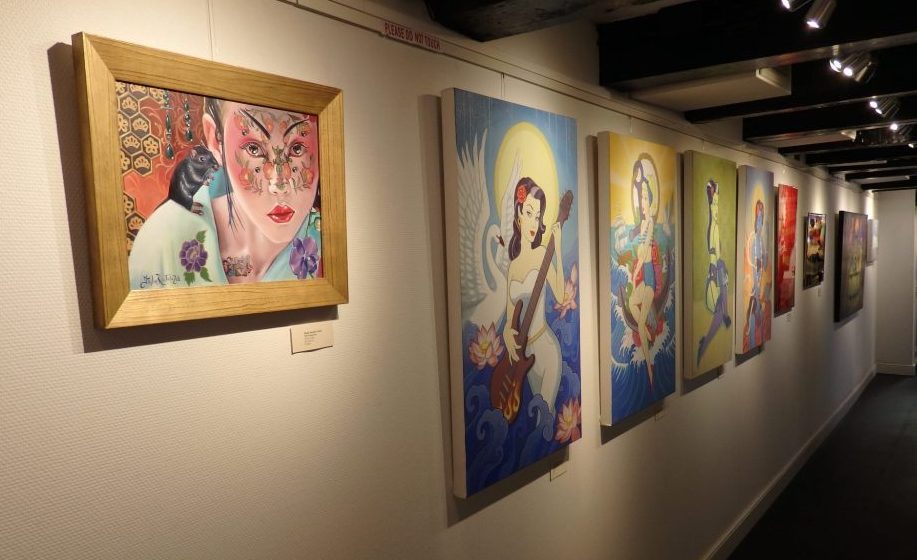
The top floor raised the most questions. Dedicated to BDSM, visitors initially walk under a small tank of water. Looking up through it, it becomes clear that the female mannequin above is peeing into it and thus simulating peeing on the museum’s visitors.
A series of photos on the wall show 50s pin-up star Betty Page in various scenes of bondage in combination with other women. Sometimes she depicts the dominatrix, sometimes the victim. Other photos show similar scenes of domination, including quite disturbing images of women tied or chained.
Racism and misogyny
I felt disappointed, both here and at the Sex Museum, that I saw no acknowledgement of the misogyny and/or racism so plainly visible in so much erotic art/pornography.
Taking fertility symbols from other cultures, as I mentioned above, and displaying them without explaining context turns them, in the eye of any uninformed Western museum visitor, into not just pornography, but racist pornography, emphasizing otherness. A different example, on the first floor, depicts an abnormally hairy, aboriginal Australian man in dreadlocks, having sex with a blond white woman: the artist has portrayed the foreign, dark-skinned man as something not quite human.
Many images in the Erotic Museum portray heterosexual sexual acts in which the woman is passive and the man is dominant. One set of these, for example, is carved on what looks like small ivory snuff bottles. Each shows two or more people in the middle of a sexual act. This particular collection brings in a racist element as well, since the figures appear Asian. Yet the bottles were made, according to the museum’s labeling, in France. This sexualizing of the “other,” even if the objects are antique, should at least be noted on the accompanying sign.
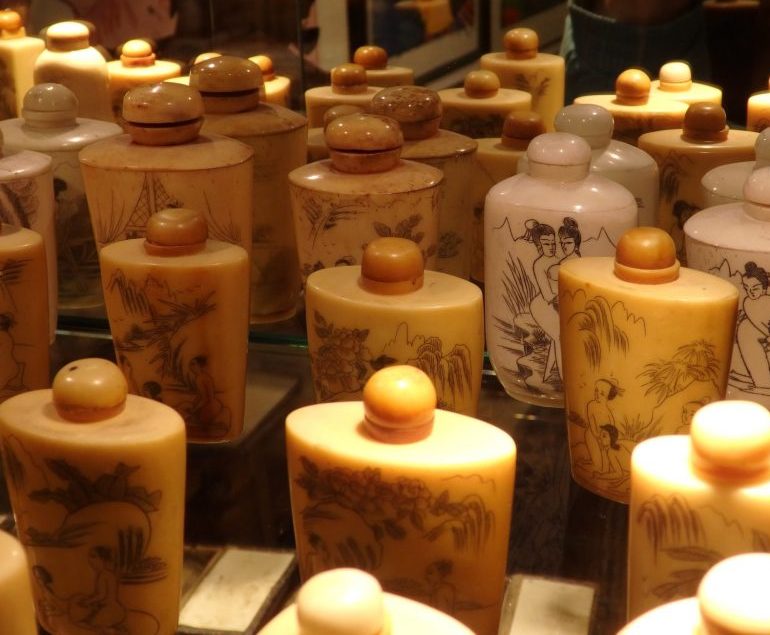
More misogyny at the Erotic Museum Amsterdam
The exhibit on the top floor about sadomasochism led to a discussion not so much about art vs. pornography but about misogyny. We could defend the pictures as acceptable – or even as art – if we assumed that no one forced or coerced the women in the photos into taking part. Yet, in seeing a photo of a bound woman from the 1950s or 60s, how could we possibly know that? Did this woman truly freely choose to be bound and photographed in this way? Would that even be possible in the context of 1950s Western society?
In any case, looking at the purpose of such photos, I don’t see how to construe them as anything but pornography. They’re meant as a turn-on. And if that is so, they indicate a clear misogyny in presenting violence against women as a source of enjoyment. There is no underlying theme or message or metaphor, as far as I could figure out.
These woman-on-woman images bring up another issue: male homosexuality. It is almost completely absent from this museum, as if the only sexuality that is worthy of portrayal is either heterosexual or lesbian, and intended for heterosexual men to enjoy.
Putting things in context
The signage is, then, one of the main problems with this museum. Some things have no labels at all, such as the collection of shackles in a case in the top floor’s BDSM section. They bear a remarkable similarity to the shackles I saw in the museums I visited in Badagry, Nigeria addressing the slave trade. Other items do have labels, but they only include the place and year of the item’s origin, and sometimes the artist.
If you’re going to show something that is historical, but blatantly racist or sexist or xenophobic or whatever, explain it. Put it in its context.
But is it art?
This may be why much of the collection struck me as more pornographic than artistic. Showing a sex act just to titillate the viewer, without any deeper message or theme, seems like pornography to me. Perhaps if the representation shows a lot of skill in its creation, it might merit the title “art.”
We also discussed identifying the art/pornography line as having something to do with how explicit the image is. Perhaps the more explicit the portrayal of a sexual act is, the more pornographic it is? After all, there are plenty of works of art that we accept as being art that involve nudes. So the problem isn’t nudity.
We never really settled the question.
If you’re planning to visit a number of museums and other sights, look into the GoCity card. It could save you some money on admission fees.
Should you visit the Erotic Museum Amsterdam?
As I also wrote about the Sex Museum, my answer to this question is “Probably not.” I think the intention is for viewers to experience the items themselves as erotic, but to me some were more disturbing than erotic. The museum is, however, marginally better than the Sex Museum. The proportion of what I would call art to what I’d call pornography is definitely higher.
Where in the Sex Museum we became almost numb from the sheer quantity of pornographic images, this museum holds a wider range of objects. It also has a lower tackiness-quotient, once you get past the Dutch mannequin on a bike in the entrance.
Neither museum really tackles sexuality directly, settling for lots of images of the human body and of sex acts. I admit to not having a clear idea of how it could be done better, but this is surely not how.
The Erotic Museum: Oudezijds Achterburgwal 54, Amsterdam. Open: Daily 11:00-01:00. Admission €8. Website.
Please add your comments below, but keep it civil and PG rated!
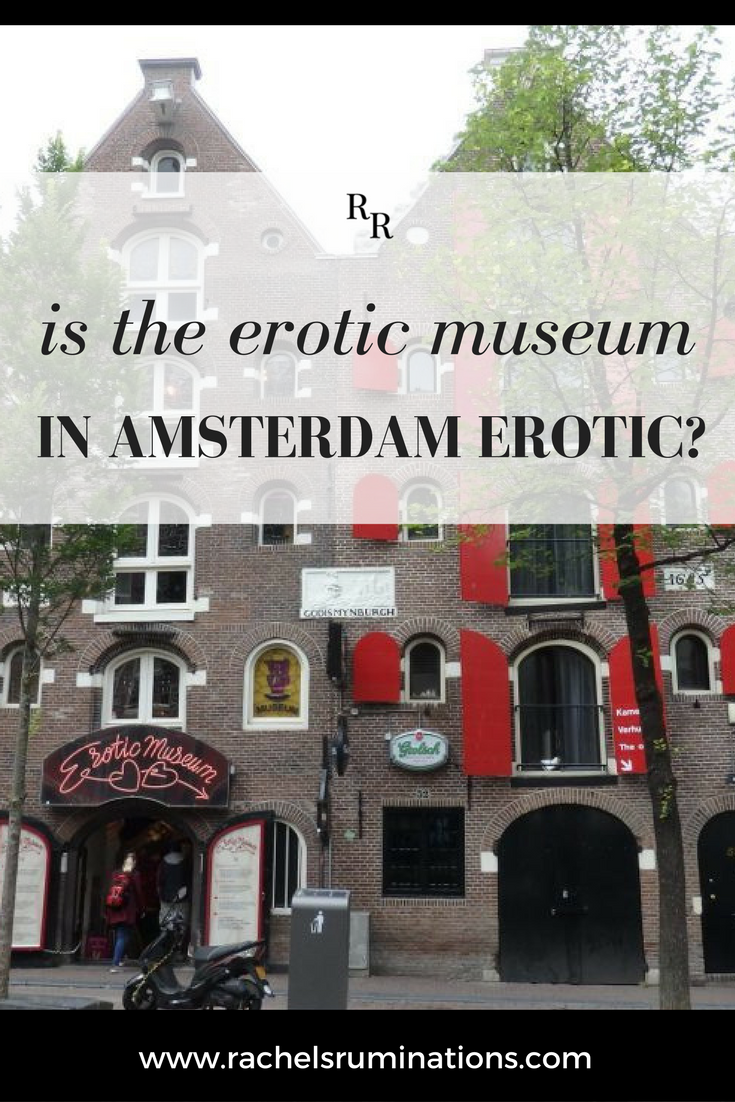
(Last updated May 19, 2024)
My travel recommendations
Planning travel
- Skyscanner is where I always start my flight searches.
- Booking.com is the company I use most for finding accommodations. If you prefer, Expedia offers more or less the same.
- Discover Cars offers an easy way to compare prices from all of the major car-rental companies in one place.
- Use Viator or GetYourGuide to find walking tours, day tours, airport pickups, city cards, tickets and whatever else you need at your destination.
- Bookmundi is great when you’re looking for a longer tour of a few days to a few weeks, private or with a group, pretty much anywhere in the world. Lots of different tour companies list their tours here, so you can comparison shop.
- GetTransfer is the place to book your airport-to-hotel transfers (and vice-versa). It’s so reassuring to have this all set up and paid for ahead of time, rather than having to make decisions after a long, tiring flight!
- Buy a GoCity Pass when you’re planning to do a lot of sightseeing on a city trip. It can save you a lot on admissions to museums and other attractions in big cities like New York and Amsterdam.
Other travel-related items
- It’s really awkward to have to rely on WIFI when you travel overseas. I’ve tried several e-sim cards, and GigSky’s e-sim was the one that was easiest to activate and use. You buy it through their app and activate it when you need it. Use the code RACHEL10 to get a 10% discount!
- Another option I just recently tried for the first time is a portable wifi modem by WifiCandy. It supports up to 8 devices and you just carry it along in your pocket or bag! If you’re traveling with a family or group, it might end up cheaper to use than an e-sim. Use the code RACHELSRUMINATIONS for a 10% discount.
- I’m a fan of SCOTTeVEST’s jackets and vests because when I wear one, I don’t have to carry a handbag. I feel like all my stuff is safer when I travel because it’s in inside pockets close to my body.
- I use ExpressVPN on my phone and laptop when I travel. It keeps me safe from hackers when I use public or hotel wifi.



At least the price is reasonable! I’ve enjoyed seeing the museums you’ve visited and enjoy your opinions.
Thanks!
You made me curious about this museum, Rachel. We don’t have anything like that here in the USA, as you probably know. The Americans are too prude for this kind of “art display”. I’ve never been in Amsterdam but I hope to make it there sometimes soon. This city has been on my list since I was growing up in Romania, but somehow I didn’t get to visit it yet.
I can’t imagine this being considered a museum in the US. And I freely admit that this museum, along with the Sex Museum, bring out the prude in me!
I can’t imagine this being considered a museum in the US. And I freely admit that this museum, along with the Sex Museum, bring out the prude in me!